Homelands: Documenting Centuries of Cham Migration
1 February 2019 - 16 September 2019
Historically, the Cham people enjoyed a rich culture; their territory including several kingdoms in what we know today as Central and Southern Vietnam. However, the Champa Kingdoms began disintegrating following decisive defeats by the Vietnamese in the 15th and 19th centuries, starting a pattern of migration and flux that is still going on today.
Early migration saw some Cham groups take refuge on Hainan Island in the South China Sea, whilst others fled to the Mekong Delta spanning Cambodia and Vietnam. More recently, in the 1970s, Cham were among the many persecuted groups during Cambodia’s murderous Khmer Rouge regime, causing thousands to flee as refugees to Malaysia, and as far as the United States, France, Australia and Canada.
Champa was one of the earliest Hindu kingdoms in Southeast Asia, but later Islam became prominent, especially among the Cham diaspora. The Cham live in their own tight-knit communities, often on the edges of mainstream society. Today, Cham are officially recognised as one of Vietnam and China’s minority ethnic groups, but remain marginalised, both culturally and economically, especially when compared to the dominant Han Chinese and ethnic Kinh Vietnamese peoples.
In 2016, photographer James Sebright travelled around the South China Sea region, meeting Cham communities in China, Vietnam, Cambodia and Malaysia. This exhibition reveals the outcomes of his work documenting the lives and livelihoods of the Cham diaspora.
 Image caption: Huixincun Village, Hainan, China, 2017 © James Sebright
Image caption: Huixincun Village, Hainan, China, 2017 © James Sebright


/prod01/channel_4/things-to-do/media/things-to-do/oriental-museum/88326-2000X665.jpg)